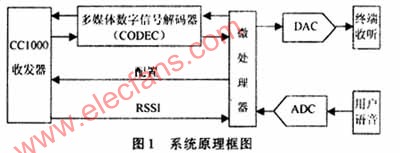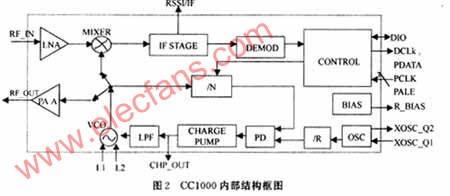With the rapid development of computer and communication technology, computer communication has been widely used, and hardware technology is changing with each passing day. Its overall trend is toward high integration, high stability, high speed, and high cost performance. The wireless headset communication system or wireless telephone hands-free device is currently a widely used form of communication. This article focuses on the use of low-power RF transceiver CC1000 to use digital radio communication to achieve information transmission through headphones.
1 System hardware structure and circuit principle
1.1 System hardware structure
The system is a wireless communication system with high integration, low bit error rate and high working performance. Its system functional block diagram is shown in Figure 1.

1.2 Principle of hardware circuit
The main part of the system is composed of a microprocessor (different models can be selected by actual application), transceivers, decoders, A / D and D / A converters. The microprocessor is used as the core to control the user's voice signal to be sampled, digitized, and compressed before being transmitted to the radio frequency. The received signal is decompressed and then converted back to an analog voice signal.
The main requirements of radio transceivers for wireless headphones are: low current consumption, low operating voltage, fast lock-in phase-locked loop (PLL), built-in digital synchronization measures, multi-frequency point capacity, few components, and cheap prices. Chipcon's CC1000RF transceiver can meet the above requirements. The half-duplex high-frequency transceiver IC CC1000 produced by Chipcon Company, he can use time-sharing duplex for two-way communication, because CC1000 only requires few components and size, so the appearance of wireless headphones can be very light and beautiful . CC1000 is an ultra-high frequency transceiver chip developed for extremely low power consumption and low voltage. His operating voltage is 2.3 ~ 3.6 V, which can make him use a single lithium manganese oxide 3.0 V button battery or lithium Ideal for thionyl chloride 3.6 V batteries. In the receiving mode, the current consumption of CC1000 is 7.7 mA; in the transmitting mode, the current consumption is 5.3 ~ 28 mA according to the output power. At 433 MHz, the output power can be programmed in 1 dB steps, the highest Up to 10 dBm; in power-down mode, the device itself has a current of 0.2 mA, which is another important feature for battery applications. CC1000 is packaged in TSSOP28, and its operating temperature range is -40 ~ + 85 ℃.
As shown in Figure 2, the internal structure of CC1000 shows that all the components that make up a complete RF transceiver are integrated inside the chip. The sensitivity of -109 dB and the high output power of 10 dBm can be constructed to provide long and reliable communication. Systems with very low distance and battery operating voltage. The CC1000 in Figure 2 has an integrated phase-locked loop (PLL) that can be programmed in 250 Hz steps, which can compensate for the temperature drift of the crystal. In addition, it also provides a multi-channel system and frequency hopping protocol for users to adjust restrictions The following working occasions are selected to enhance system reliability when the communication band is crowded. Finally, CC1000 also provides an integrated bit synthesizer and RSSI, and through 5 I / O lines, you can easily interface with the microprocessor.

2 System workflow
2.1 System communication flow diagram
To facilitate the explanation of the signal transmission process, a block diagram of the communication process is given below, as shown in Figure 3.

2.2 Technical requirements for wireless headset communication
It can be drawn from engineering practice: for telephone systems that transmit voice, most adults ’voice bandwidth is about 10 kHz, while most understandable language frequency ranges are only 0.3 to 3.3 kHz, which is available from empirical data. In the network system, when the guard band is used, the 4 kHz bandwidth band can be used to transmit voice.
In digital telephone systems, pulse code modulation (PCM) is generally used to convert analog signals into digital signals. In order to meet the needs of Nyquist Sampling Theorem, first, the restricted frequency band of 4 kHz speech transmission is sampled at a rate of 8 kHz, and each sample is then translated into an integer, such as using 13 b , The integer should be between -4 096 and 4 095. To effectively transmit speech, non-average quantization technology can be used to reduce the word length. In order to preserve the quality of the sound signal, the word length can be compressed from 13 b to 8 b or less. Non-average quantization technology is generally composed of multimedia on hardware The digital signal codec CODEC is implemented and can be used in software to look up tables or calculate in real time. After the above processing, the 8 kHz sampling rate combined with the compression method generates an 8 b word, and the digital sound signal flow is therefore said to be 64 kb / s wireless voice communication. The public telephone network is full-duplex. However, implementing a full-duplex radio system will require the receiving and transmitting departments to share many system modules. Such systems involve more complex circuit solutions. Half-duplex radio systems are relatively more space-saving and cost-saving. Full-duplex on wireless systems generally uses the time-division duplex (TDD) technical solution. The signal is actually unidirectional transmission, but because the transmission direction is switched only a short Time (≤100 ms), the ears of ordinary people are indistinguishable, so two-way conversation is possible. In order to maintain the call flow, when using TDD technology, the digital voice signal buffer at one end of the caller must be temporarily stored. The 64 kb / s voice signal flow requires at least 128 kb / s wireless TDD data communication, and the rotation from receiving to transmitting Time requires even higher rates.
High rate requires greater RF bandwidth or advanced modulation technology. In order to reduce the rate of transmitting digital voice signals, another layer of coding technology needs to be introduced. Adaptive audio pulse coding (ADPCM) or continuous variable slope incremental modulation (CVSD) are suitable. These schemes are based on the basic concept of differential encoding is to send the difference of the current sample instead of sending the absolute value from the sample. After using ADPCM encoding, 8 b can be encoded into 4 b, 3 b or 2 b, and the 64 kb / s rate can be reduced to 32, 24 or 16 kb / s. If the 32 kb / s ADPCM coding technology is used, it will not bring a heavy burden to the microprocessor. Compressor and ADPCM, CODEC chip are available on the market.
3 Conclusion
Whether it is due to the trend or worrying about the impact of phone radiation on the brain, wireless phone hands-free devices (referred to as headsets) must be an indispensable accessory for mobile phones, and the number can be said to be synchronized with mobile phones. Therefore, the system has broad market prospects.
Bluetooth (Bluetooth) is considered to be the solution to all mobile phones that require additional communication in the future due to interoperability. However, for the current wireless headsets, Bluetooth is not a technology with competitive price, regardless of development costs or raw material costs. In this regard, CC1000 can meet the existing market demand and become a low-cost, low-power wireless headset alternative.
Product categories of Storage Battery, we are specialized in manufacturers from China,Storage Battery Supplier suppliers/factory, wholesale high-quality products of manufacturing, we have the perfect after-sales service and technical support. Look forward to your cooperation!
Storage Battery
Solar Battery,Storage Battery,Solar Storage Battery,Solar Energe Storage Battery
Changxing Deli Technology Co., Ltd. , https://www.delipowers.com